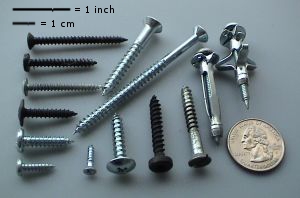Fastener facts for kids
A fastener is a special tool or device that helps join two or more objects together. Think of them as tiny helpers that connect different parts. Fasteners are often used to create connections that can be taken apart later, unlike glue or welding which are usually permanent. Most fasteners are made from strong metals like stainless steel, carbon steel, or alloy steel. You can find them almost everywhere, from your bicycle to the furniture in your home!
Contents
What Are Fasteners Used For?
Fasteners are super important because they allow us to build and fix many things. They create connections that are strong enough to hold parts together, but also flexible. This means you can often undo the connection if you need to repair something, replace a part, or even move it. For example, the screws holding your computer case together let you open it up to upgrade parts.
Common Types of Fasteners
There are many different kinds of fasteners, each designed for a specific job. Here are some of the most common ones you might see:
Screws and Bolts
Screws and bolts are very popular fasteners. They both have a threaded shaft that helps them grip into materials.
How Screws Work
A screw usually has a pointed end and a head with a slot or shape for a screwdriver. When you turn a screw, its threads cut into the material, creating a strong hold. Screws are great for joining wood, plastic, or thin metal. They are often used in furniture, toys, and electronics.
Bolts and Nuts
A bolt is like a screw, but it usually doesn't have a pointed end. Bolts are designed to go through a hole in two or more objects. To hold them in place, you use a nut on the other side. The nut has threads inside that match the bolt's threads. When you tighten the nut, it pulls the objects together very securely. Bolts and nuts are often used in heavy-duty construction, cars, and large machines because they can handle a lot of force.
Nails and Rivets
Nails and rivets are also common fasteners, but they work a bit differently.
Nails
A nail is a simple, pointed piece of metal, usually with a flat head. You drive a nail into materials, like wood, using a hammer. Nails hold things together by friction and by the material gripping around them. They are very common in building houses and making wooden objects. Unlike screws and bolts, nails are generally harder to remove without damaging the material.
Rivets
A rivet is a permanent fastener. It's a smooth metal pin with a head on one side. To use a rivet, you put it through holes in the objects you want to join. Then, you deform the other end of the rivet, usually by hammering or using a special tool, to create a second head. This locks the objects together permanently. Rivets are often used in aircraft, bridges, and metal structures where a very strong and lasting connection is needed.
Other Useful Fasteners
Besides screws, bolts, nuts, nails, and rivets, there are many other types of fasteners:
- Washers: These are flat, ring-shaped discs placed under a bolt head or nut. They help spread the load, prevent loosening, and protect the surface of the material.
- Pins: Pins are simple, unthreaded fasteners used to align parts or prevent movement. There are many types, like cotter pins or dowel pins.
- Clips and Clamps: These are used to hold things together, often temporarily. Think of paper clips, binder clips, or hose clamps.
- Staples: Similar to nails but usually U-shaped, staples are driven into materials to hold them together, often used in upholstery or paper.
Materials for Fasteners
Fasteners are made from different materials depending on where they will be used.
- Steel: This is the most common material because it's strong and affordable.
- Stainless Steel: This type of steel resists rust and corrosion, making it perfect for outdoor use or in wet environments.
- Brass: Brass fasteners are often used for decorative purposes or in situations where they need to resist corrosion, like in plumbing.
- Plastic: Some fasteners are made from plastic, especially for lightweight applications or where electrical insulation is needed.
The right material ensures the fastener will last and do its job well!
Images for kids
-
Structural bolt DIN 6914 with DIN 6916 washer and UNI 5587 nut
See also
 In Spanish: Anclaje (fijación) para niños
In Spanish: Anclaje (fijación) para niños



